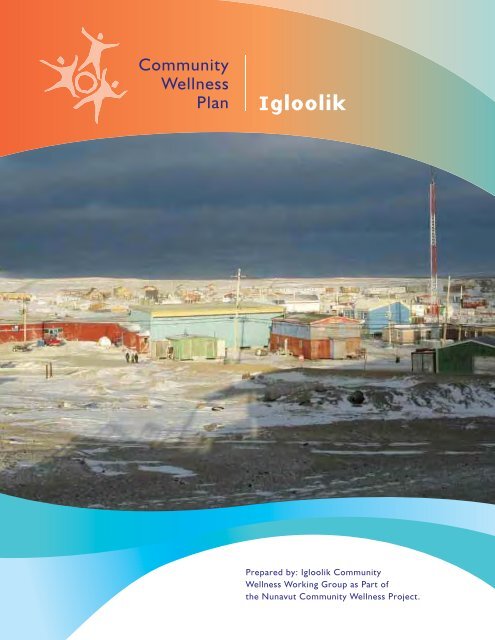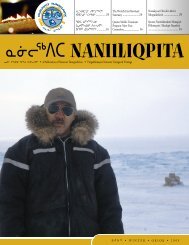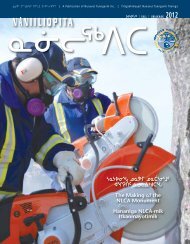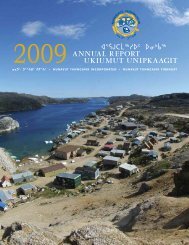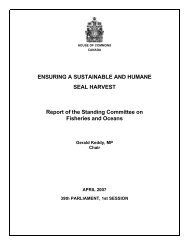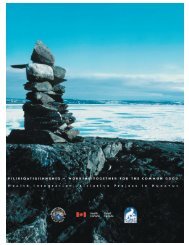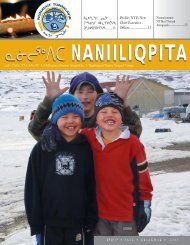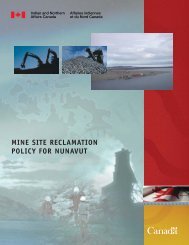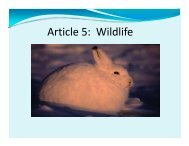Community Wellness Plan â Igloolik - Nunavut Tunngavik Inc.
Community Wellness Plan â Igloolik - Nunavut Tunngavik Inc.
Community Wellness Plan â Igloolik - Nunavut Tunngavik Inc.
- No tags were found...
You also want an ePaper? Increase the reach of your titles
YUMPU automatically turns print PDFs into web optimized ePapers that Google loves.
<strong>Community</strong><strong>Wellness</strong><strong>Plan</strong><strong>Igloolik</strong>Prepared by: <strong>Igloolik</strong> <strong>Community</strong><strong>Wellness</strong> Working Group as Part ofthe <strong>Nunavut</strong> <strong>Community</strong> <strong>Wellness</strong> Project.
<strong>Igloolik</strong> <strong>Community</strong> <strong>Wellness</strong> <strong>Plan</strong>The <strong>Nunavut</strong> <strong>Community</strong> <strong>Wellness</strong> Project was a tripartite project led by <strong>Nunavut</strong> <strong>Tunngavik</strong> <strong>Inc</strong>. in partnershipwith Government of <strong>Nunavut</strong>, Department of Health and Social Services and Health Canada.<strong>Community</strong> <strong>Wellness</strong> <strong>Plan</strong>ning Committee of <strong>Igloolik</strong> is happy to share photos of their land and community in this publication.July, 2011
table of contentsPAGE2 1. Introduction2 2. <strong>Community</strong> <strong>Wellness</strong> Working Group3 2.1 Purpose of Working Group3 2.2 Description of the Working Group5 3. <strong>Community</strong> Overview6 4. Creating Awareness in the <strong>Community</strong>6 4.1 Description of <strong>Community</strong>-Based Awareness Activities7 5. What are the Resources in Our <strong>Community</strong>7 5.1 <strong>Community</strong> Map and Description (From Assets Exercise)8 5.2 <strong>Community</strong> Assets and Description (From Asset Mapping Exercise)8 6. <strong>Community</strong> Vision for <strong>Wellness</strong>8 6.1 Process for Identifying Vision9 7. Issues Identification9 7.1 Process for Identifying <strong>Wellness</strong> Issues11 7.2 What are the <strong>Wellness</strong> Issues11 7.3 <strong>Community</strong> Goals (Prioritized)11 8. <strong>Community</strong> <strong>Plan</strong>11 8.1 Connecting Assets to <strong>Wellness</strong> Vision (from Assets Exercise)11 8.2 Steps to Reach Goals and Objectives11 9. Conclusions12 10. Signatories of Working Group13 Appendix I – <strong>Community</strong> Businesses, Organizations and Committees16 Appendix II – <strong>Community</strong> Goals and <strong>Wellness</strong> Issues19 Appendix III – Assets to <strong>Wellness</strong> Vision20 Note Page
2 <strong>Community</strong> <strong>Wellness</strong> <strong>Plan</strong> | <strong>Igloolik</strong>1. IntroductionThe <strong>Nunavut</strong> <strong>Community</strong> <strong>Wellness</strong> Project (NCWP) is a partnership between <strong>Nunavut</strong> <strong>Tunngavik</strong><strong>Inc</strong>orporated (NTI), the Government of <strong>Nunavut</strong>’s Department of Health and Social Services (HSS), andHealth Canada’s Northern Region (HC). The stated goal of the NCWP is to increase the participationof Inuit in the development and delivery of health programs and services in <strong>Nunavut</strong>, which respondsin part to the requirement outlined in Article 32 of the <strong>Nunavut</strong> Land Claims Agreement. The NCWPresults from recommendations made for a <strong>Community</strong> <strong>Wellness</strong> Strategy as outlined in the HII report,Piliriqatigiinngniq – Working Together for the Common Good. 1The six communities chosen for the project are Clyde River, <strong>Igloolik</strong>, Kugaaruk, Kugluktuk, Arviat andCoral Harbour.The original goals and objectives of the project are:• To develop and implement integrated <strong>Community</strong> <strong>Wellness</strong> <strong>Plan</strong>s in 6 communities in <strong>Nunavut</strong>,in order to leverage existing capacity, increase human resource capacity, create economies of scaleand broaden access to services in those communities;• Use best practices from this project that could be developed into community wellness planningtemplates to facilitate similar wellness planning initiatives in other <strong>Nunavut</strong> communities; and• Contribute towards the ability of individual <strong>Nunavut</strong> communities to identify and address their ownhealth issues, needs, options and priorities, in order to improve the health and wellbeing of theirpeople.The following <strong>Community</strong> <strong>Plan</strong> is a result of extensive work undertaken by the community of <strong>Igloolik</strong>from March 2009 – October 2010.2. <strong>Community</strong> <strong>Wellness</strong> Working GroupFollowing the initial <strong>Nunavut</strong> <strong>Community</strong> <strong>Wellness</strong> Project (NCWP) workshop held in Iqaluit in February2009, three residents of <strong>Igloolik</strong> were selected by the <strong>Community</strong> Health Representative (CHR) to form the<strong>Igloolik</strong> <strong>Community</strong> <strong>Wellness</strong> Working Group (ICWWG). The individuals were selected based upon theirexperience with health and wellness issues in the community.One of the first activities of the ICWWG members 2 was to organize a meeting with the hamlet’s SeniorAdministrative Officer SAO) to advise him of the Iqaluit workshop and its outcome. Following this initialmeeting, various community organizations were contacted in order to invite representatives to be a part ofthe ICWWG. The group held their first meeting on March 16 th , 2009.1. <strong>Nunavut</strong> <strong>Tunngavik</strong> <strong>Inc</strong>orporated. Piliriqatigiinngniq- Working Together for the Common Good. 20062. Bartholemew Hannah Kappianaq, Lydia Palluanuk Qaunaq and Salome Kangok
<strong>Igloolik</strong> | <strong>Community</strong> <strong>Wellness</strong> <strong>Plan</strong>32.1 Purpose of Working GroupThe objective of the ICWWG was to develop a wellness plan for the community which would include thefollowing elements:• Establish a <strong>Community</strong> <strong>Wellness</strong> Working Group with membership from community leaders andcommunity organizations;• Hire and supervise a coordinator reporting to the ICWWG to manage the planning process;• Inform the community about the project and develop a list of issues and assets based on publicconsultations;• Develop a <strong>Community</strong> <strong>Wellness</strong> <strong>Plan</strong>;• Present the <strong>Community</strong> <strong>Wellness</strong> <strong>Plan</strong> to GN, NTI, and HC; and• Maintain ongoing communication and work with support team members from of New EconomyDevelopment Group/USIQ Communications (NEDG/USIQ).2.2 Description of the Working GroupMembershipThe ICWWG has eleven members including a NCWP coordinator. Members on the ICWWG represent anumber of different organizations in the <strong>Igloolik</strong> community.MeMbers InClude:rolenaMeCoMMunIty roleChairperson Vincent Pickett Ataguttaaluk SchoolMember Celestino UyarakHamlet of <strong>Igloolik</strong>Member Salome Kango <strong>Community</strong> Health RepMember Elisapee QuassaInullariit Elders GroupMember Micah Arreak <strong>Community</strong> <strong>Wellness</strong> CoordinatorMember Madeline IvaluElder/Movie ActorMember Leah Ivvalu Elementary School CounsellorMember Guy Makkik ElderMember Bart Hannah Kappianaq Hamlet CouncillorMember Julia AmaroalikEldersTraditional CounsellorCoordinator Louise Haulli <strong>Igloolik</strong> Committee <strong>Wellness</strong> Working Group
4 <strong>Community</strong> <strong>Wellness</strong> <strong>Plan</strong> | <strong>Igloolik</strong>Governance DocumentsThrough the planning undertaken by the coordinator and chairperson, it was determined that theICWWG would meet on a monthly basis. Upon consideration of the timelines that needed to followed,the committee members decided that they would meet once a week in order to complete the planningprocess in a timely manner.The agenda for the weekly meetings is prepared by the coordinator with direction from the chairpersonsubsequent to any information or decisions made outlined in the minutes of previous meeting minutes.Most meetings were between one and two hours in duration but would on occasion last longer if required.During meeting, the coordinator took the minutes of the meeting and prepared them for distributionamongst the members prior to the next meeting. Votes were taken when decisions had to be taken butusually the members would discuss a topic or idea that was put forward until the item was clarified. Oncethe issue was discussed and a decision made regarding the benefit to the community, members wouldvote or come to a consensus on the matter.
<strong>Igloolik</strong> | <strong>Community</strong> <strong>Wellness</strong> <strong>Plan</strong>53. <strong>Community</strong> Overview(Population, Economy, Places and People of Interest)Map madeavailable by InuitTapiriiit Kanatami,www.itk.ca<strong>Igloolik</strong> is located on a small island in Foxe Basin that is very close to the Melville Peninsula (and to a lesserdegree, Baffin Island). The name “<strong>Igloolik</strong>” means “there is an igloo here” in Inuktitut and the residents arecalled Iglulingmiut (~miut – “people of”). Information about the area’s earliest inhabitants comes mainlyfrom numerous archaeological sites on the island; some dating back more than 4,000 years. <strong>Igloolik</strong> isnot only the geographic centre of <strong>Nunavut</strong> but is also widely considered to be the hub of Inuit culturein <strong>Nunavut</strong>.
6 <strong>Community</strong> <strong>Wellness</strong> <strong>Plan</strong> | <strong>Igloolik</strong>The area has long been blessed with abundant natural resources central to Inuit culture and identity:walruses, seals, whales, polar bears, caribou, fish and waterfowl. These resources continue to provide theeconomic, spiritual and intellectual basis for cultural continuity within <strong>Igloolik</strong>. People in <strong>Igloolik</strong> takeimmense pride in nurturing Inuit heritage and traditions while embracing the inevitable changes broughton by modernization. The challenge in maintaining this balance is the very essence of <strong>Igloolik</strong>’s vibrancy.Although Inuktitut is the dominant language spoken in <strong>Igloolik</strong>, English is also spoken by a majority ofresidents. In the 2007, the Government of <strong>Nunavut</strong> census recorded the population as 1,443. Of course,this figure is debated regularly by community members, and estimates of the population often rangebetween 1,600 to 2,000. As in most <strong>Nunavut</strong> communities, there is the usual Northern Store and the ArcticCo-operatives (hotel and grocery). The Tujurmivik Hotel is a locally-owned and operated hotel/restaurant.The very successful Isuma Productions is located here as well. The community has a number of “famous”people, including the award winning producer/director of the movies Atanarjuat: The Fast Runner Trilogy,Zacharias Kunuk. As Mr. Kunuk uses local residents for his movies with many of the faces one would seein his movies also being seen walking on the streets of <strong>Igloolik</strong>. Luke Airut and Bart Hannah Kappianaq areinternationally renowned and recognized carvers. Mayor Paul Quassa helped negotiate the <strong>Nunavut</strong> LandClaims Agreement with the federal government, as well has holding two terms as President of NTI.4. Creating Awareness in the <strong>Community</strong>4.1 Description of <strong>Community</strong>-Based Awareness ActivitiesThe ICWWG is active in the community and holds weekly meetings. These meetings are organized bythe coordinator who announces the meetings over the local radio station. This not only reminds themembers of the meetings but also to advise the community that the working group is actively meeting.The ICWWG also increases public awareness by conducting a number of public events including hostinga portion of the Christmas games at the community hall and holding a community meeting thatfollowed with a feast. In the weeks following this community meeting, the ICWWG prioritized the listof community concerns raised in the meeting and established five top priorities. The Coordinator thencontacted a number of community groups to invite them to discuss community issues and priorities andto explore how these organizations could work with the community to achieve the identified priorities.Five committees/organizations participated in discussions including the Daycare Committee; theIkajurasuartiit Elder’s Group, the Recreation Committee, the Youth Committee, and the Inullariit Society(a group that works with both Elders and youth). Prior to the prioritizing of the issues, approximatelyforty letters were sent out from the ICWWG to businesses and organizations requesting input oncommunity issues. 1An early initiative undertaken by the ICWWG to introduce the project was to hold a radio show widelyheard by community residents. Three additional radio shows were held over several months. The showsgenerally lasted between one and two hours. The shows introduced the NCWP project, the coordinator,the chairperson, the vice-chairperson and two members who spoke about the background and purposeof the project. 2 Following the initial background information on the NCWP, the lines were opened up tothe community to call-in to voice their concerns and pose questions regarding the NCWP and communitywellness. In addition to these radio shows, the ICWWG attended hamlet council meetings to keep themayor and council abreast of the groups’ progress. More than half of the community was advised of theNCWP chiefly due to the radio shows and public announcements made. The coordinator’s reminderson the radio about the project, regular committee meetings, community meeting and community feastproved to be very effective in raising public awareness of the NCWP and the ICWWG.1. Please refer to Appendix 1 – <strong>Community</strong> Resources for a list of the businesses and organizations contacted.2. Bart Hannah Kappianaq, Micah Arreak, Elisapee Quassa, and Julia Amarualik with interpretation by Celestino Uyarak
<strong>Igloolik</strong> | <strong>Community</strong> <strong>Wellness</strong> <strong>Plan</strong>75. What are the Resources in Our <strong>Community</strong>5.1 <strong>Community</strong> Map and Description (From Assets Exercise)
8 <strong>Community</strong> <strong>Wellness</strong> <strong>Plan</strong> | <strong>Igloolik</strong>5.2 <strong>Community</strong> Assets and Description (From Asset Mapping Exercise)Assets in <strong>Igloolik</strong> appear to be plentiful and include the Recreation Committee, Social Services, theMunicipal <strong>Community</strong> <strong>Wellness</strong> Coordinator, two Elders’ groups (Inullariit and Ikayurasuartiit), the RCMP,Health and Social Services, the Alcohol Committee, and the Youth Committee. In general, the communityfeels that the daily activities of the RCMP, HSS, and MCWC help the community on an ongoing and dailybasis and these assets support one another on a preventative basis. However, unilingual Inuit need to beable to get more information in their language in order to know what is truly accessible in the community.In addition, more Inuktitut resources would help people gain a better understanding of what eachorganization is doingOrganizations such as those noted above are essential to the wellness of any community. They providepreventative and support services in terms of wellness on a broad scale. In addition, businesses in <strong>Igloolik</strong>work together to serve the community better. At times, businesses will donate space, resources and othernecessary items for wellness projects. Most businesses also provide space for meetings and gatherings.6. <strong>Community</strong> Vision for <strong>Wellness</strong>6.1 Process for Identifying VisionDuring a regular ICWWG meeting, a community vision was drafted. The group brainstormed what“<strong>Wellness</strong>/<strong>Community</strong> <strong>Wellness</strong>” meant to everyone. The suggestions discussed in the meeting wereas follows:• Treatment programs are available for drug users in our community;• Children’s wellness is enhanced by having parents stay home with their children at night, spendtime with them at home and enjoy their time with them;• Young people doing chores for Elders/adults;• There is responsible parenting, children and grandchildren learning listening skills throughtraditional ways;• Connection, Consistency and Continuity;• For the younger generation to stop the confrontation with their Elders or to person older thanthem and to follow through the Inuit traditional respecting practices;• Less drug abuse, more physical activities;• Crime rate at least reduced by 50% in the community;• For the community to build positive attitudes (verbally and physically); and• To have community wellness become a reality in <strong>Igloolik</strong>.
<strong>Igloolik</strong> | <strong>Community</strong> <strong>Wellness</strong> <strong>Plan</strong>9The definition of “wellness” included <strong>Igloolik</strong> being a beautiful place with citizens connected to eachother in a multicultural, healthy community, with peace/serenity/tranquility, people caring for each other,and vibrant and happy people.The workshop facilitator used a helpful tool “Create a Vision” that assisted the working group achieveits objective.7. Issues Identification7.1 Process for Identifying <strong>Wellness</strong> IssuesThe range of issues that were identified in the community meeting were collected in a number of waysincluding holding a community meeting, ICWWG meetings, radio shows and meetings with localcommittees. The priorities identified were then listed in three different, but equally important, categories:community, business and recreation. In addition, priorities were also classified as being low, medium orhigh priority. An implementation timeline was developed for the implementation of each priority, whetherit was immediate, months or years. Following the community meeting in March 2009, where residentslisted their own priorities on a list, the ICWWG met to review and prioritize the issues. The meeting waschaired by the chairperson of the ICWWG, and interpreting was provided by one of the members. Themeeting agenda was kept straightforward and included items such as having Inuit games as an ice-breaker,the introduction of committee members, a discussion of community wellness, identification of the assetsthe group had in the community, a community discussion on issues, and next steps. All the wellness issuesidentified by the ICWWG were written and posted publicly for community members to review. There wasalso a large sheet provided with space for community members to write down the issues they wanted tosee missing from the list. The participants at the meeting were invited to review the issues and write downwhat they felt was most important to them in their community in regards to wellness.
10 <strong>Community</strong> <strong>Wellness</strong> <strong>Plan</strong> | <strong>Igloolik</strong>
<strong>Igloolik</strong> | <strong>Community</strong> <strong>Wellness</strong> <strong>Plan</strong>117.2 What are the <strong>Wellness</strong> IssuesSee Appendix II - ICWPG Goals and <strong>Wellness</strong> document attached7.3 <strong>Community</strong> Goals (Prioritized)See Appendix II - ICWPG Goals and <strong>Wellness</strong> document attached8. <strong>Community</strong> <strong>Plan</strong>8.1 Connecting Assets to <strong>Wellness</strong> Vision (from Assets Exercise)See Appendix III attached.8.2 Steps to Reach Goals and ObjectivesDuring the most recent meeting of the ICWWG, the list of priorities was reviewed and categorized intowhat was the most important of the issues, the priorities that required the least amount of time and effortto accomplish, and who would be responsible for working to achieve these priorities. In total, there wereforty-six issues listed by meeting participants with the hope that they could be achieved over the next tenyears. Of these forty-six issues, nine were addressed as discussion issues and then later filtered into the topfive issues. The ICWWG reviewed the top five priorities to determine how they would go about addressingthem and came to the conclusion that meetings would be organized with the five departments/organizationsresponsible for each specific area (i.e. for the daycare centre priority, a meeting would be held with the DaycareCommittee etc.) These meetings would determine a reasonable length of time in which the goals could be met.9. ConclusionsOne of the primary positive observations achieved during the course of the ICWWG’s work was seeing thegroup work closely together in the spirit of piliriqatigiinngiq (the common good). Members were able toshare information regarding the project, their thoughts and how these community priorities would cometo fruition. During the initial stages of the meeting process, there was a language barrier for the unilingualInuit but after working so well together, the problem seemed to rectify itself. There was a broader visionof the community’s wellbeing developed that was more reflective of the whole community rather thanindividual issues. The community was able to see that there was, in fact, wellness in the community. Andnow that wellness was seen in different perspectives, they simply needed refinement in how to furthersupport and achieve a broader wellness. The community in general was able to see that where there mayhave not been apparent wellness in the past, it was apparent now in areas many never expected to find.There was a more positive view in the community since the various ICCWB exercises, meetings and consulta -tions were undertaken. The Elders were becoming more active, they were no longer afraid of venturingout on their own, and they were generally excited about the future. The ICWWG will continue to monitorthe progress towards achieving the wellness priorities to ensure they are in accordance with the identifiedtimeline. In the future, the ICWWG hopes to convene a gathering in the community to celebrate the successof the project and to thank the members, organizations and members of the community for their hard work.
12 <strong>Community</strong> <strong>Wellness</strong> <strong>Plan</strong> | <strong>Igloolik</strong>10. Signatories of Working Group
<strong>Igloolik</strong> | <strong>Community</strong> <strong>Wellness</strong> <strong>Plan</strong>13APPENDIX I – <strong>Community</strong> Businesses, Organizationsand CommitteesI. IgloolIk busInesses*naMe ofbusInesstyPe ofbusInessnuMber of eMPloyees(full time/Part time)Aqiqiq StoreBaffinland Iron MinesSmall retail outlet(open seasonally)<strong>Community</strong> LiaisonOffice for Mining Company2 PT1 FTFirst Air Airline Airport Staff 2 PT<strong>Igloolik</strong> Isuma Film and Media 3 FT (when filming, dozensProductions <strong>Inc</strong>.of locals are employed)Inuit BroadcastingCorporation Radio and television 1 PTNorthern StoreLarge Corporate retail store;Post office is locatedthere as well35 (17 FT/18 PT)<strong>Nunavut</strong> PowerCorporationSavik EnterprisesBusiness Management and(<strong>Inc</strong>ludes Canadian Development; MechanicNorth airline employees)andMaintenance 6 (4 FT/2 PT)LRT Construction/Carl’s WoodworkingConstruction/Real EstateHoldingcompany 17 (2 FT/6 PT)Kopak’s Taxi Taxi Service 3 PTTujurmivik HotelHoteland restaurant 12 (6 FT/6 PT)Housing Association* This list was first compiled in May 2009, some changes may have occurred
14 <strong>Community</strong> <strong>Wellness</strong> <strong>Plan</strong> | <strong>Igloolik</strong>II. IgloolIk CoMMunIty organIzatIonsnaMe ofbusInesstyPe ofbusInessnuMber of eMPloyees(full time/Part time)<strong>Igloolik</strong> Co-operative SocialEnterprise: co-operative 30PT<strong>Igloolik</strong> Inn retail outlet; gas bar; cable and 23 FTtelephone services; coffee (in the spring will increaseshop and convenience store to about 72 employees)<strong>Igloolik</strong> Early InterventionEarlychildhood education,Project (Head Start) parenting, women’s cultural 7 FT/27 PTactivities, evening+ volunteersfamily programs(#’s unavailable)Hunter’s and Trapper’sAssociationInullarit Society Support for Elders Volunteer+ 1 Administrative positionPublic LibraryLocal library; housed in schoolAnglican Mission Anglican Church 1 Minister, maintenanceand assistantsGlad Tidings Pentecostal Church 2 Leaders, several volunteersCatholic Mission Roman Catholic Church 1 Priest, 1 Clergyman, volunteersIsumaksarksiuvik(Women’s Group)Women’s support group,traditionalwomen’s activitiesUnknown(volunteer’s)Elder’s CommitteeHamlet Elders’ Committee 13 membersArtCirq Performance youth troupe 5Core members;combining circus and Inuit 17 other membersart/themesincluding 1 ElderIkajurasuartiit Committee Health and <strong>Wellness</strong>Committee with a focus onElders on helping young parents 10 Members (Elders)Alcohol EducationCommitteeYouth CentreHousing AssociationPermits,awarenessPlace for youth to gather;recreation1 FT2 PT; volunteers
<strong>Igloolik</strong> | <strong>Community</strong> <strong>Wellness</strong> <strong>Plan</strong>15III. HaMlet standIng CoMMIttees1. Recreation2. <strong>Plan</strong>ning and Lands3. By-Law4. Search and Rescue5. Economic Development6. Health and Social Services7. Justice8. Radio Society9. Cadets10. Rangers11. Director of Municipal Public Works12. Observer Communicator13. Arena14. Municipal Liaison Officer15. Fire Chief16. Elementary School17. High School18. Mayor19. RCMP20. Health Centre21. Mental Health Nurse22. <strong>Community</strong> GovernmentIV. reCreatIonMaren Vsetual, Recreation Director, has a complete list of recreation facilities and programs/activities.V. VaCant buIldIngsIn progress
16 <strong>Community</strong> <strong>Wellness</strong> <strong>Plan</strong> | <strong>Igloolik</strong>APPENDIX II – <strong>Community</strong> Goals and <strong>Wellness</strong> Issues<strong>Igloolik</strong> <strong>Community</strong> <strong>Wellness</strong> <strong>Plan</strong>ning Group (ICWPG)<strong>Community</strong> PrioritiesGroup/Category A list is from number 1-24Group/Category B list is from number 25-45 accordinglyThe five suggestions made by the community and committee over the past seven months of consultationare the most important issues and concerns facing the community at present.Areas the ICWPG should consider in their planning process as follows:• The next step is for the ICWPG to meet with each of the groups individually and look at strategies ofhow we can work together to make this project a success;• Different aspects of the problems in the community will be brainstormed with attention being paidas to how speed up the process of making these community priorities become a reality soonerrather than later; and• A reasonable time target will be developed that identify key dates for starting, going through theplanning process and completing the project.List of issues that need to be considered and discussed during the public meeting and that the communityplanning committee members should note are:1. Inuit families (including husband and wife and their children) do not help one another as much asthey traditionally did in past;2. The misuse of finances and wasting of money by all individual family members, on gambling,substance abuse and on prostitution is increasing;3. The community has been waiting for a new <strong>Community</strong> hall for the longest time that the residentsare less active and attending fewer activities;4. The individuals that have been given any authority or made decisions on behalf of the community,do not consult with community members adequately and do not inform the community beforeand after decisions are made, causing frustration and adding to the issues facing the community;5. The second generation Inuit descendents are too obsessed with sex and promiscuity is toorampant, resulting in an increase in more young women becoming pregnant. This results in morechild protection services being used to intervene in most cases due to young women havingchildren prematurely. This in turn causes displaced and homeless children;6. Inuit Elders are financially abused by their adult children and grandchildren for useless trivialwasteful things;7. Inuit Elders are emotionally abused by their extended families especially younger adults;8. All schools include in their individual school curriculum Inuit methodologies on life and copingskills, facilitated by local Inuit Elders; and9. Local churches are not fulfilling their traditional role of acting as mediators for disputes, causingmistrust and anger among all the parties involved and creating a lack of morality among the people.
<strong>Igloolik</strong> | <strong>Community</strong> <strong>Wellness</strong> <strong>Plan</strong>17grouP asuggestIonsIssues/ConCernstyPe• <strong>Community</strong>• Business• RecreationPrIorIty• Low• Medium• HighIMPleMentatIontIMe• Immediate• Months• YearsDaycare Centre <strong>Community</strong> 1st HighHealing Centre <strong>Community</strong> 2nd HighOutdoor RecreationalPark/Area Recreation 3rd HighYouth Centre <strong>Community</strong> 4th HighElders Centre <strong>Community</strong> 5th HighThe following table provides a list of priorities/issues concerns of howthe residents would like to see <strong>Igloolik</strong> in the next 10 years.suggestIonsIssues/ConCernstyPe• <strong>Community</strong>• Business• RecreationPrIorIty• Low• Medium• HighIMPleMentatIontIMe• Immediate• Months• Yearsnotes1. Movie Theatre2. Acting Workshops/Facility3. <strong>Community</strong> Hall4. Arcade5. Picnic Area6. Bicycle Race Track7. Trampolines8. Middle School9. Food Bank10. Qarmaqs/Sod Houses11. By-Law Officer12. Campground for InuitCultural Programs13. Tutoring14. Upgrading of Life Skills15. Confidential healingprograms (Rape Victims)chart continued on the next page
18 <strong>Community</strong> <strong>Wellness</strong> <strong>Plan</strong> | <strong>Igloolik</strong>suggestIonsIssues/ConCernstyPe• <strong>Community</strong>• Business• RecreationPrIorIty• Low• Medium• HighIMPleMentatIontIMe• Immediate• Months• Yearsnotes16. More Elders ’Radio Shows17. Real Coffee Shop18. Blue Bins19. Advanced InuktitutSpeaking and Writing20. Inuit Youth huntingMentoring Program21. Iglulik Island Clean-up22. RBC/CIBC Bank23. No Sports on Sunday24. More Inuit Workingin supporting Rolesi.e. Social Work25. A Tidy <strong>Igloolik</strong>26. Revise Curling Rink27. Make better useof Facilities28. Bowling Alley29. Wooden Garbage boxes30. Business clean-uptheir areas31. Country food bank32. Bring in legal aid lawyersto discuss rights33. Bring in Marriagecounsellors fortroubled couples34. Have communityorganizations settledisputes35. Minimize Alcoholand Drug Abusein <strong>Community</strong>36. Use Elders to agreater degreechart continued on the next page
<strong>Igloolik</strong> | <strong>Community</strong> <strong>Wellness</strong> <strong>Plan</strong>19suggestIonsIssues/ConCernstyPe• <strong>Community</strong>• Business• RecreationPrIorIty• Low• Medium• HighIMPleMentatIontIMe• Immediate• Months• Yearsnotes37. Sitting area on beachfor Elders in warmermonths38. Drug RehabilitationCentre39. A place for Elders only,not a hang out for others40. Laundromat41. Hamlet Clean-up ofPublic places42. Driving school for HighSchool students/public43 Skidoo/vehicle partsgarage44. Financial advisors forlocal families45. Build Qarmakresidential areasAPPENDIX III – Assets to <strong>Wellness</strong> Vision1. Hunters and Trappers Association - Could provide the country food bank2. Inullarit Society /Ikajurasuartiit Committee - Using Elders more effectively, decision making onthe Elders centre, decision making on qamaq (as in advisement of location), Inuit youth huntingmentoring, campground to learn traditional living3. Isumaksarksiuvik (Women’s Group) - Organization of the beautifications around town,4. ArtCirq – Acting workshops, could play a role to help minimize drugs and alcohol among youth5. Alcohol Education Committee – Minimizing alcohol abuse in the community,6. Youth Centre – Tutoring, consulting in/with issues concerning youth7. Recreation – Making better use of facilities, picnic area, bike track8. By-Law – Assist in driving school9. Health and Social Services – Marriage counselors for troubled couples, assist in getting legal aidlawyers to discuss human rights issues10. Justice – Have community organization to settle community disputes11. Municipal Liaison Officer – Tidy <strong>Igloolik</strong>12. Health Centre – Drug rehab centre13. Mental Health Nurse – Confidential healing; rape victims, spousal abuse, child abuse14. RCMP – minimizing drug and alcohol abuse in the community, using Elders to a greater capacity;rehabilitation, counselling
20 <strong>Community</strong> <strong>Wellness</strong> <strong>Plan</strong> | <strong>Igloolik</strong>notes


